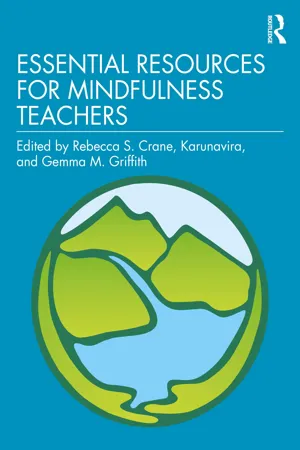A freshness in the center of your chest.
Two centuries later Hafiz described it as:
The city inside your chest.
This ‘freshness’ or ‘city’ is outside of space and time, outside of personal intelligence, outside of needing to get anything, outside of transforming yourself or anyone or anything – no attaining, no non-attaining, no completeness or incompleteness – simply being. This is the non-instrumental actuality of meditation and MBPs, the intelligence that is already complete within you, and within those with whom you work. This intelligence does not need to be acquired but rather, remembered. This is the real curriculum, the real guide; the deep spring from which MBP teaching flows out of you and makes its way into the world. You might consider returning to this water whenever you need a reminder of who and what you are behind all the words and forms described in any MBP curriculum guide. This ‘freshness’ that is available to you whenever you become lost or tired, overextended or discouraged or simply in need of rest and ease; the refreshment of not needing to pursue any aim at all. I suspect that if you allow yourself the space, you’ll discover for yourself that holding too firmly to the instrumental inevitably blinds you to the non-instrumental
Like Russian Matryoshka dolls, the instrumental is nested within the non-instrumental. If this were not the case, how could you learn anything? How could you love anyone, if love were not an innate attribute of your being? How could you ache and feel tenderness in the orbit of another’s pain, if empathy wasn’t inherent? Surely, we can learn to become increasingly familiar with these attributes through deliberateness and practice. However, if they were not already part and parcel of who and what you are, occluded as they may be in most of us, you would have no reference point for loving, compassionating, (as Walt Whitman says) or assuming your measure of universal responsibility for the wellbeing of the world.
Look at MBP teaching as a ‘thing’ and you’ll miss it. See it as a pattern of relationships – a pulsating, ever-changing expression of life unfolding and you’ll discover it. If MBPs are worth anything, their worth lies in their aliveness. Their aliveness rests in the basic ungraspability of the curriculum. Seen from this vantage point, the vantage point of the non-instrumental, then the answer to the question, “has the curriculum changed?” is “yes”. The curriculum has changed because, like everything else in the world, it is constantly changing. Likewise, who and whatever you think of as ‘you’ is also continually changing. This dynamic flux is none other than the creative nature of Rumi’s ‘universal intelligence’ reflected through you and embodied as you. And, of course, as you grow and deepen and surrender more fully into what you are behind the occlusions, the curriculum changes quite naturally, deepening and expanding into new expressions, endlessly ....
Ultimately, and in a very palpable way, the ‘curriculum’ of MBPs are none other than your life intersecting and comingling with the lives of the people you will have the privilege of sharing in and engaging with week by week in the teaching space. The suffering, the inconstancy, the lack of a solid, concrete ‘self’ – the wish for relief of suffering and the longing for wellbeing that you carry within you, and all the people you will ever work with carry within them – is the curriculum, the vital life of MBP teaching.
Now, as you enter into the stream of learning and teaching MBPs, my invitation to you is to realize that the real guide for teaching any MBP curriculum is always available inside of you, always awaiting your attention, always resting in your completeness outside of any notions of here and now, past and future, time and space.
